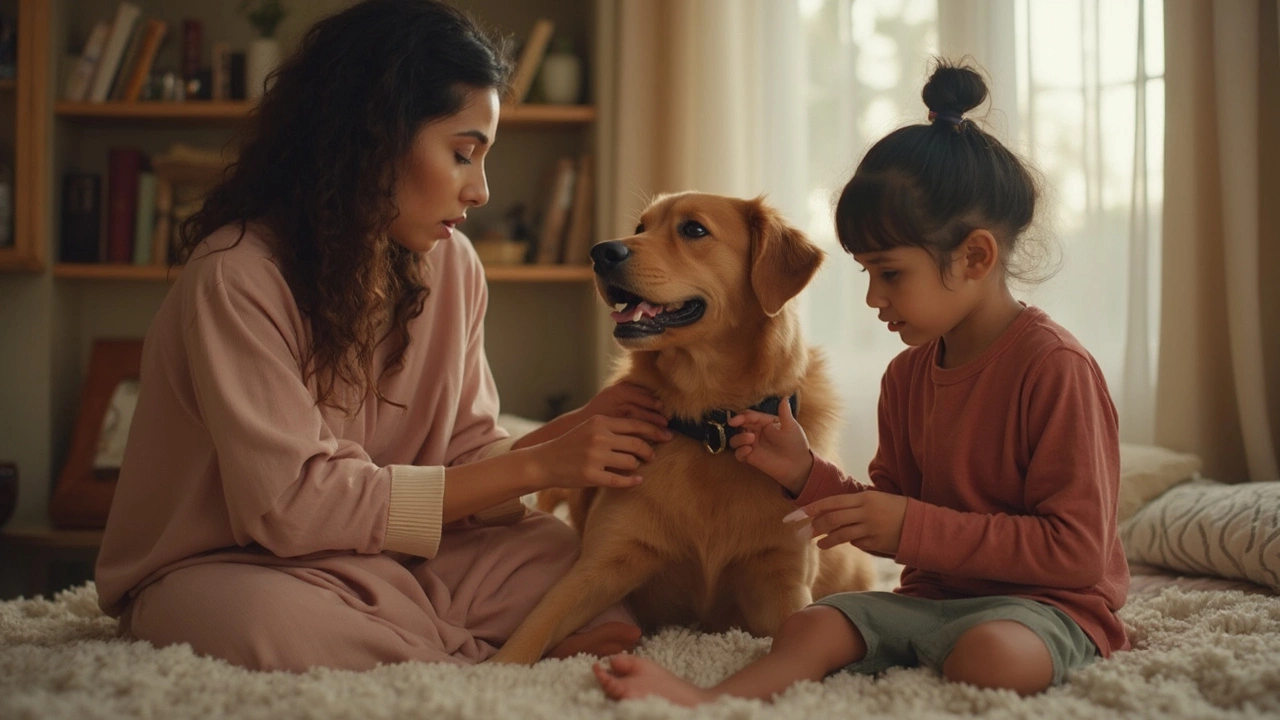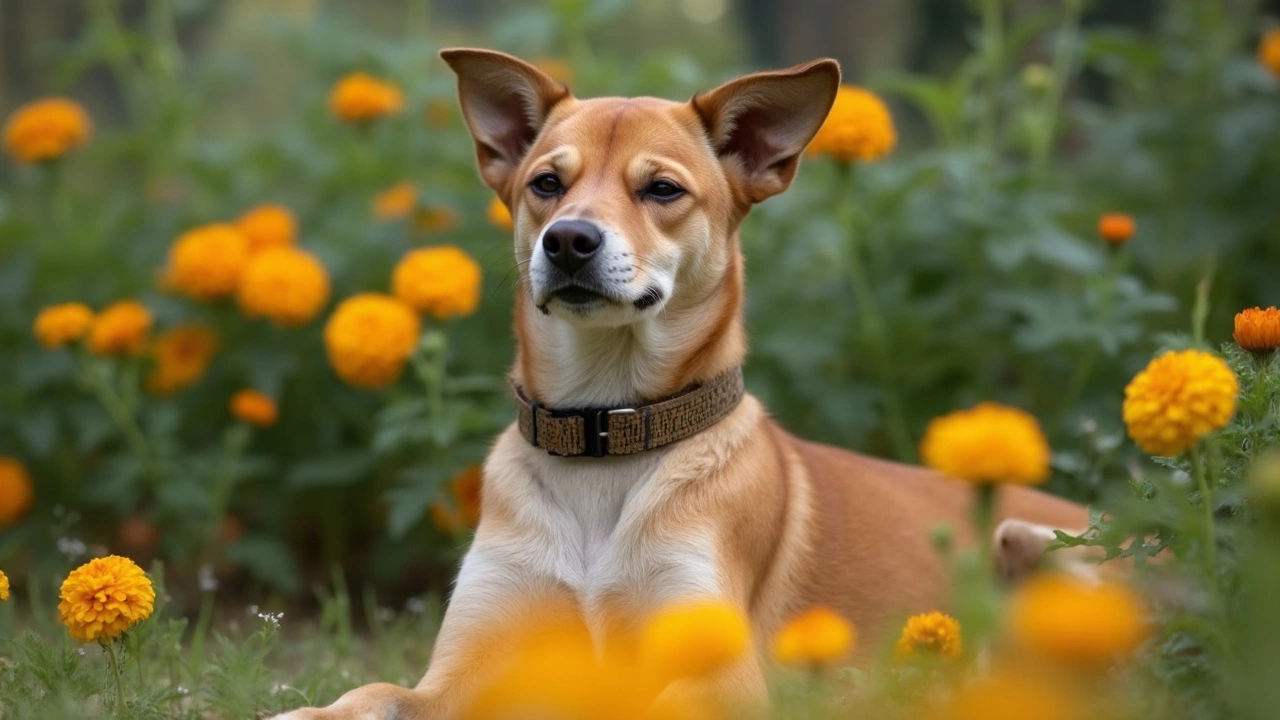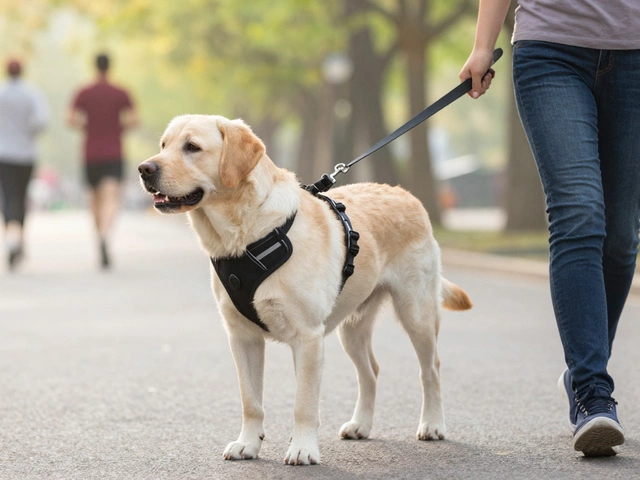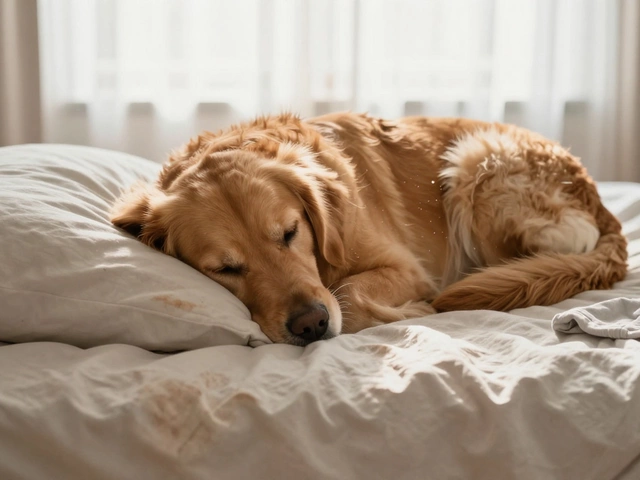
If you’ve ever wondered whether that collar around your dog’s neck gets annoying after a while, you’re not alone. It seems harmless, but imagine wearing a snug band around your neck all day, every day. Some dogs don’t mind, but others might be bothered—and the signs aren’t always obvious.
Collars are pretty standard because they hold ID tags and make leash walks a breeze. But, comfort matters. Most folks don’t think about how a collar can rub, pinch, or trap grime under all that fur. If your dog scratches at their neck a lot or you see bald spots, those are red flags. Grab a few minutes during cuddle time to peek under their collar for any redness or chafing. A quick check goes a long way.
- Daily Collar Comfort: What Dogs Actually Feel
- Can Collars Hurt or Cause Problems?
- Day vs. Night: When to Remove the Collar
- Choosing the Right Collar: Materials and Fit
- Easy Collar Care: Cleaning and Inspections
- Real Talk: Balancing Safety and Comfort at Home
Daily Collar Comfort: What Dogs Actually Feel
Most dogs end up wearing a collar from the time they’re pups. But does that mean it feels good all the time? Not exactly. Dogs have thicker skin on their neck than we do, but collars can still press, pull, or irritate, especially if they’re too tight or left on nonstop. Some dogs act like they don’t even notice, while others get fidgety or scratch at their neck like something’s bugging them.
What really happens is that a collar puts constant pressure on one spot. If your dog has sensitive skin, is super active, or has a thick or thin coat, this pressure can get uncomfortable. A study from the Royal Veterinary College found that some dogs—especially those with allergies or thin fur—had more collar-related skin problems like hair loss or redness.
Dogs don’t always complain the same way people do. Instead, you might catch them:
- Scratching or pawing at their neck
- Acting restless when the collar is on
- Trying to slip out of the collar
- Rubbing their neck against furniture
- Losing fur under the collar
Also, collars can sometimes get tangled in your dog’s fur, especially if they’ve got a long, fluffy coat. Mats under the collar hurt, and if left unchecked, can cause skin infections.
The real trick is to make wearing a dog collar as comfy as possible. Watch how your dog acts with and without the collar. Quick comfort checks make a big difference. If your dog acts happier or less itchy when the collar comes off, that’s your answer right there.
Can Collars Hurt or Cause Problems?
Most people slap on a collar and forget about it, but there are some real issues that come up if dogs wear collars nonstop. Collars can rub the same spot day in and day out, leading to raw skin, bald patches, or infection. Even a so-called "comfy" collar made from soft material can cause trouble if it’s too tight or stays damp after a wet walk.
Pressure on the neck gets risky, especially with pulling or quick movements. According to a 2019 UK animal welfare study, around 20% of collar-wearing dogs get some sort of neck, skin, or trachea problem during their lives. Collars too loose? Dogs can get legs or jaws caught, which is just as bad as one that's too tight. Puppies and growing dogs outgrow collars fast, so not adjusting can cause choking or damage to the windpipe.
- Certain skin issues, like hot spots or rashes, often start under collars.
- Dogs with allergies can react to cheap nylon or plastic collars and metal buckles.
- Flat-faced breeds (like pugs or bulldogs) are more at risk since their necks are short and sensitive.
Noticing odd behavior? If your dog pulls away when you touch their collar, or if you smell anything funky coming from their neck, that’s a clue. Here’s a quick look at common collar problems:
| Problem | Common Cause | Typical Sign |
|---|---|---|
| Skin Irritation | Friction/moisture | Redness, scabbing |
| Neck Injury | Certain leash pulls | Coughing, yelping |
| Allergic Reaction | Collar material | Rash, scratching |
| Matting & Hair Loss | Constant contact | Bald spots under collar |
So, yes, collars can lead to more than a little discomfort—they can trip up your dog's health if you don't watch for the signs. The good news is, a well-fitted dog collar, regular checks, and giving your pup collar-free breaks solve most problems before they even start.
Day vs. Night: When to Remove the Collar
So, do dogs need to wear a collar all the time—even while napping or snoring under your bed? During the day, most people keep the collar on because it holds your dog's ID tags. If your pup darts out the door, those tags make a huge difference in getting them home fast. That’s one big reason collars matter so much.
But at home, especially at night or when your dog is chilling inside, it’s totally okay—even smart—to let them go collar-free. Vets and trainers point out that sleeping in a collar can cause rubbing, fur loss, and sore spots. Dogs with sensitive skin or little fur around their neck are at higher risk for irritation when the collar stays on round the clock. Give that neck a breather so your dog doesn’t wake up itchy and uncomfortable.
Here’s a quick rule: If your dog is safely indoors, take the collar off before bed. It only takes a few seconds. Want more peace of mind? Some folks use breakaway collars at night. These unlatch if they get caught on something, avoiding accidents. If you’re worried about emergencies, microchips add a solid layer of backup protection—no collar needed for identification.
- Take off your dog’s collar every night if they sleep inside.
- Look for bald spots, redness, or even marks after long collar use—these mean it’s time for a break.
- Keep one collar handy for walks, playtime outside, and visits out of the house.
Always think about your dog’s comfort, not just what’s easy for you. Rotating between collar-on during the day and collar-off at night keeps your dog’s neck healthy and happy. That way, you make the most of the safety of a dog collar—without risking your buddy’s comfort.

Choosing the Right Collar: Materials and Fit
The collar isn’t just about holding tags—getting the material and fit right is a big deal for your dog’s comfort and health. Some pups are fine with most collars, but others get itchy just looking at nylon. So what should you actually look for?
The safest bet is to pick a collar that’s lightweight, smooth, and sturdy. Nylon is the go-to for lots of folks because it’s cheap and easy to wipe down. Leather is strong and lasts a long time, but you need to keep it dry or it’ll get funky and stiff. There’s neoprene and biothane, too—these are awesome for dogs who swim or have skin issues since they don’t soak up water and are gentle on the skin. Steer clear of rough stitching or plastic edges if your dog’s got sensitive skin or a history of chafing.
The fit matters just as much as the material. Your collar should be snug but not tight. Here’s a simple test: slip two fingers under the collar. If you can do that easily, you’re in the clear. Anything tighter is risky—it can cause fur loss, skin marks, or even trouble swallowing. Too loose? Your dog could back out of it on walks. Adjustable buckles are helpful, especially for puppies and growing dogs.
- Check your dog’s collar fit every few weeks, especially if they’re growing or gaining weight.
- Look for signs the collar is irritating—redness, bald patches, or your dog constantly scratching at it.
- Swapping to a padded collar can help for dogs prone to chafing or those with thin fur.
- Make sure the tags or D-rings aren’t digging into your dog’s neck—it’s easy to miss this until there’s a problem.
Getting the right dog collar isn’t just about looks. Comfort and dog collars safety go hand in hand here. Don’t settle for something that just “works”—pay attention to how your dog acts and looks while wearing it. The right fit makes life better for both of you.
Easy Collar Care: Cleaning and Inspections
A dirty collar isn’t just gross—it can actually bug your dog’s skin and even cause bald spots or infections. Sweat, dirt, and loose fur build up fast, especially if your pup is into rolling or swimming. Keeping a collar fresh isn’t hard, but it’s one of those things dog owners forget until it smells or looks rough.
Give your dog’s collar a once-over every week. Slide a finger underneath and check for dampness, grime, or anything sharp poking out. If it looks grimy or smells weird, it’s cleanup time. Here’s a quick way to keep things in check:
- Take the collar off and check both sides, not just the outside.
- Toss it in warm, soapy water. Use gentle dish soap and scrub with a toothbrush if needed.
- For leather collars, skip soaking—just wipe with a damp cloth and follow up with leather conditioner.
- Let everything dry completely before putting it back on your dog’s neck. Wet collars = skin problems.
- Check the hardware (buckles, tags) for rust or sharp bits. Replace anything that looks dodgy.
Collars made of nylon or polyester hold up to a wash about once a month, while leather might need some extra care but less frequent cleaning. According to a recent pet health survey, up to 30% of skin issues on dogs’ necks come from old or dirty collars.
| Collar Material | Recommended Cleaning | Notes |
|---|---|---|
| Nylon/Polyester | Monthly (or more if needed) | Can air dry |
| Leather | Every 2-3 months | Use leather cleaner/conditioner |
| Metal Chain | Monthly | Check for rust |
Don’t forget to inspect under the collar for any skin trouble at least once a week. Redness, bumps, or missing fur means it’s time for a break—or maybe a better-fitting dog collar. Set a reminder in your phone if you need to. Your dog will thank you with fewer itchies and happier tail wags.
Real Talk: Balancing Safety and Comfort at Home
There’s always a bit of a trade-off when it comes to leaving a collar on your dog all the time. The big question is—what keeps your buddy both safe and comfy? At home, where escape risk is low, plenty of vets suggest giving your dog a break from their collar whenever possible. This lets their skin breathe and lowers the odds of snagging, matting fur, or neck irritation.
For example, Dr. Marty Becker, known as “America’s Veterinarian,” puts it simply:
“Dogs should never wear collars 24/7. Breaks can keep their necks healthy, especially for indoor pets,”he says. He’s got a point—problems like hot spots and even pressure sores are real if collars never get a break.
But let’s talk real-life stuff. If you have a fenced yard or live in a quiet area where your dog can’t wander off, it’s totally fine to remove the collar when you’re both at home. Just keep your dog’s ID attached to an easy-access harness or have microchip info up to date, just in case.
If your area sees a ton of door traffic, guests, or delivery folks, having the collar on during busy times keeps things simple if Fido slips outside. Safety and routine matter, but so does comfort. It’s totally doable to find a middle ground.
- Let your dog go collar-free at night or when just hanging inside.
- Check under the collar every day for any weird smells or red spots.
- If you need to leave the collar on a lot, consider a softer fabric or padded style, and adjust it regularly.
- Keep your pet’s microchip info up to date—it’s the backup plan for lost ID tags.
Wondering why this matters? A study published in 2023 in "Veterinary Dermatology" showed that about 15% of dogs develop some skin irritation from always wearing a collar (especially badly fitting ones).
| Factor | Risk Level (Always Collared) | Risk Level (Collar Breaks) |
|---|---|---|
| Skin Irritation | High | Low |
| Lost Pet Risk | Low | Moderate |
| Accidental Choking | Moderate | Very Low |
| Comfort for Dog | Low | High |
Bottom line? Finding that sweet spot between safety and comfort is totally doable. Your dog’s peace and health are worth a few seconds to check the collar or take it off when home is a safe space. When it comes to dog collars, a little attention really does go a long way.





